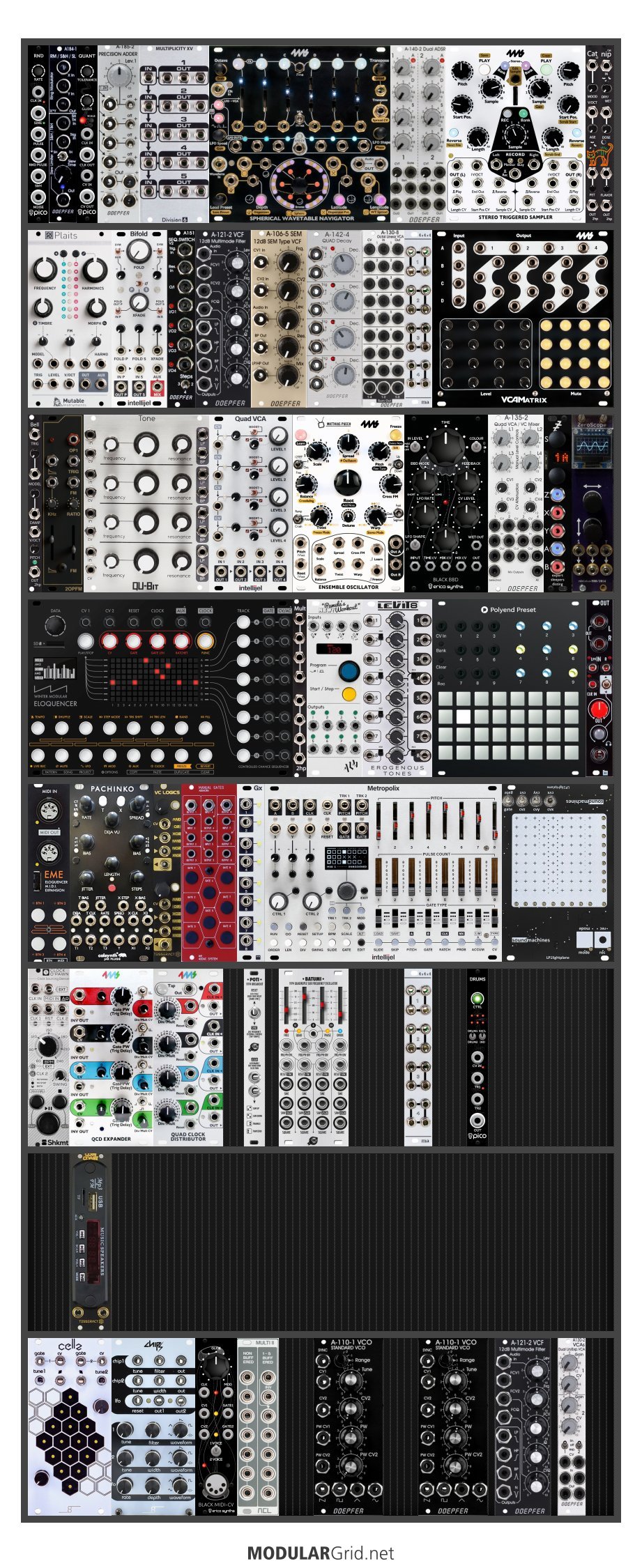As before, top five rows are my main 15Ux84hp rack, the last three are smaller racks I keep for screwing around with stuff like Orca, generative music, &c.
This rearrangement was best described in a comment on an r/modular hangout thread. The TL;DR is that instead of sticking sound sources at the top, modulation in the middle, and control at the bottom (as everyone else does and as I have done for some time), I varied it a bit based on an explicit signal routing plan. I made the plan away from the rack and from MG, just focusing on how I wanted the signals to go; then, I planned the rack in MG, and used the patch tool to assess how cable usage. (This one planning exercise on 420hp of stuff more than justifies paying for Unicorn status, for me anyway.)
As of now, I have everything wired up, except for the 2hp mult (4 jacks for clock, 4 for reset) and Pam's, both of which should be here early next week
For the sake of completeness, and to keep you from having to click through, here's the full explanation from r/modular:
I'm rearranging my rack to make room for a new PNW. Pam's looks to be so versatile with LFO options that I'm taking a chance on moving my Batumi to the portable case.
It's not just for the Pam's, though. Last night I was having frustration with signal routing and which voices went to which effects loops. Later, I happened upon a video of DivKid and Chris Meyer where Meyer talked about the "backbone patch" in his portable case. That lit a fire under me, so I grabbed a legal pad, packed a bowl, took an inventory of my voices, effects, VCAs, and mixers, and mapped everything out. (Lesson: I could use a few more VCAs. Just a few. And maybe a Befaco Hexmix with expander. Not that I have room in my main rack for any of it.)
After that, I spent way too long on ModularGrid sorting out a new layout that optimized for short connections within my new signal routing scheme, then virtually patching up my backbone patch. It still has compromises (like running a pitch & gate cable bus from Eloquencer to SWN), but overall I'm looking forward to setting up a partial plumbing patch that will stay patched and let me focus on sound design and music instead of playing Signal Routing Puzzle Hour™.
I have learned things through this exercise:
- Thinking it through in deeper detail than I have before, and understanding (through practice) how I want to use complex modules like the SWN, changed how I laid things out. I haven't completely broken away from the top-to-bottom sounds/filters/modulation/control paradigm, but I've done it a lot more thoughtfully, and in a way that makes the most of my rack.
- I have a more balanced proportion of voices, modulators, and VCAs than I thought.
- I now understand what the A-130-8 is for, and it's this. I was relegating it to CV mixing, but when I thought through my patch I saw how much I could do with the Octal VCA and a bucket of 3-inch patch cables next to a mixer, and then just leave it patched and forget about it. (I'll mix CV with Levit8, which is better for the purpose anyway.)
- I had to be at this over a year to cultivate the knowledge of my instrument that would make planning 420hp + an outboard a worthwhile exercise. If I'd have tried this at the outset, the plan would have been trash. Trial & error experiments were the right way to proceed before; this was the right time to take a swing at a master plan.
This layout has other little advantages as well. For example, I have four percussion voices going through my Intellijel Quad VCA. The 6db boost switch and the Quad's ability to distort and add a little grit is perfect for making drums a little punchier. Making better use of the Octal VCA let me move the A-135-2 - my "clean" VCA/mixer - into position as my final mixer before going out. That position used to be held by the VCA Matrix, which is now much happier in its role as signal router and effect loop send.
I'll post back here if I wind up adjusting it substantially after playing.


